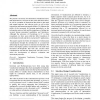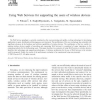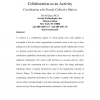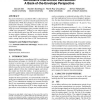2015 search results - page 143 / 403 » Hidden Software Capabilities |
APVIS
2003
13 years 11 months ago
2003
© We present a taxonomy for Information Visualization (IV) that characterizes it in terms of data, task, skill and context, as well as a number of dimensions that relate to the in...
SEC
2004
13 years 11 months ago
2004
Trusted Computing gives rise to a new supply of trusted third parties on which distributed systems can potentially rely. They are the secure system components (hardware and softwa...
DSS
2007
13 years 9 months ago
2007
The Web Service paradigm is currently considered as the most promising and rapidly evolving technology for developing applications in open, distributed and heterogeneous environme...
CSCW
2002
ACM
13 years 9 months ago
2002
ACM
A coalition is a collaborative pattern in which people must work together to accomplish a task, but where organizational constraints stand in the way of their making use of the co...
HOTNETS
2010
13 years 4 months ago
2010
Successive interference cancellation (SIC) is a physical layer capability that allows a receiver to decode packets that arrive simultaneously. While the technique is well known in...




